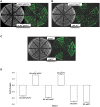Intrinsic plasmids influence MicF-mediated translational repression of ompF in Yersinia pestis
- PMID: 26347736
- PMCID: PMC4543863
- DOI: 10.3389/fmicb.2015.00862
Intrinsic plasmids influence MicF-mediated translational repression of ompF in Yersinia pestis
Abstract
Yersinia pestis, which is the causative agent of plague, has acquired exceptional pathogenicity potential during its evolution from Y. pseudotuberculosis. Two laterally acquired plasmids, namely, pMT1 and pPCP1, are specific to Y. pestis and are critical for pathogenesis and flea transmission. Small regulatory RNAs (sRNAs) commonly function as regulators of gene expression in bacteria. MicF, is a paradigmatic sRNA that acts as a post-transcriptional repressor through imperfect base pairing with the 5'-UTR of its target mRNA, ompF, in Escherichia coli. The high sequence conservation and minor variation in the RNA duplex of MicF-ompF has been reported in Yersinia. In this study, we utilized super-folder GFP reporter gene fusion to validate the post-transcriptional MicF-mediated regulation of target mRNA ompF in Y. pestis. Unexpectedly, upon MicF overexpression, the slightly upregulated expression of OmpF were found in the wild-type strain, which contradicted the previously established model. Interestingly, the translational repression of ompF target fusions was restored in the intrinsic plasmids-cured Y. pestis strain, suggesting intrinsic plasmids influence the MicF-mediated translational repression of ompF in Y. pestis. Further examination showed that plasmid pPCP1 is likely the main contributor to the abolishment of MicF-mediated translational repression of endogenous or plasmid-borne ompF. It represents that the possible roles of intrinsic plasmids should be considered upon investigating sRNA-mediated gene regulation, at least in Y. pestis, even if the exact mechanism is not fully understood.
Keywords: MicF-ompF; Yersinia pestis; intrinsic plasmid; sRNA regulation; translational fusion.
Figures




Similar articles
-
Plasmid pPCP1-derived sRNA HmsA promotes biofilm formation of Yersinia pestis.BMC Microbiol. 2016 Aug 4;16(1):176. doi: 10.1186/s12866-016-0793-5. BMC Microbiol. 2016. PMID: 27492011 Free PMC article.
-
Annotation and evolutionary relationships of a small regulatory RNA gene micF and its target ompF in Yersinia species.BMC Microbiol. 2003 Jun 30;3:13. doi: 10.1186/1471-2180-3-13. BMC Microbiol. 2003. PMID: 12834539 Free PMC article.
-
Superfolder GFP reporters validate diverse new mRNA targets of the classic porin regulator, MicF RNA.Mol Microbiol. 2012 May;84(3):428-45. doi: 10.1111/j.1365-2958.2012.08031.x. Epub 2012 Mar 28. Mol Microbiol. 2012. PMID: 22458297
-
MicF: an antisense RNA gene involved in response of Escherichia coli to global stress factors.J Mol Biol. 2001 Oct 12;313(1):1-12. doi: 10.1006/jmbi.2001.5029. J Mol Biol. 2001. PMID: 11601842 Review.
-
Genetic Regulation of Yersinia pestis.Adv Exp Med Biol. 2016;918:223-256. doi: 10.1007/978-94-024-0890-4_8. Adv Exp Med Biol. 2016. PMID: 27722865 Review.
Cited by
-
Nutrient depletion may trigger the Yersinia pestis OmpR-EnvZ regulatory system to promote flea-borne plague transmission.Mol Microbiol. 2019 Nov;112(5):1471-1482. doi: 10.1111/mmi.14372. Epub 2019 Sep 13. Mol Microbiol. 2019. PMID: 31424585 Free PMC article.
-
Extending the dynamic range of transcription factor action by translational regulation.Phys Rev E. 2016 Feb;93(2):022404. doi: 10.1103/PhysRevE.93.022404. Epub 2016 Feb 4. Phys Rev E. 2016. PMID: 26986359 Free PMC article.
-
A Small Non-Coding RNA Mediates Transcript Stability and Expression of Cytochrome bd Ubiquinol Oxidase Subunit I in Rickettsia conorii.Int J Mol Sci. 2023 Feb 16;24(4):4008. doi: 10.3390/ijms24044008. Int J Mol Sci. 2023. PMID: 36835430 Free PMC article.
-
Environmental Regulation of Yersinia Pathophysiology.Front Cell Infect Microbiol. 2016 Mar 2;6:25. doi: 10.3389/fcimb.2016.00025. eCollection 2016. Front Cell Infect Microbiol. 2016. PMID: 26973818 Free PMC article. Review.
-
Plasmid pPCP1-derived sRNA HmsA promotes biofilm formation of Yersinia pestis.BMC Microbiol. 2016 Aug 4;16(1):176. doi: 10.1186/s12866-016-0793-5. BMC Microbiol. 2016. PMID: 27492011 Free PMC article.
References
-
- Andersen J., Forst S. A., Zhao K., Inouye M., Delihas N. (1989). The function of micF RNA. micF RNA is a major factor in the thermal regulation of OmpF protein in Escherichia coli. J. Biol. Chem. 264, 17961–17970. - PubMed
LinkOut - more resources
Full Text Sources
Other Literature Sources

